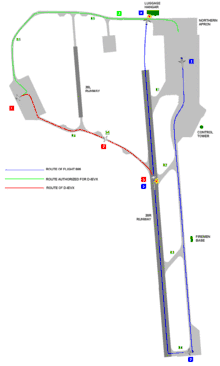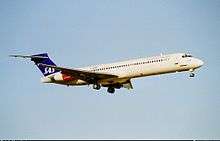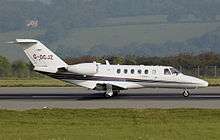Linate Airport disaster
The Linate Airport disaster occurred on 8 October 2001 at Linate Airport in Milan, Italy, when Scandinavian Airlines Flight 686, a McDonnell Douglas MD-87 airliner carrying 110 people bound for Copenhagen, Denmark, collided on take-off with a Cessna Citation CJ2[1]:1 business jet carrying four people bound for Paris, France. All 114 people on both aircraft were killed, as well as four people on the ground.
 A map of Linate Airport, showing the paths of the two aircraft. The blue line marks the path of the MD-87. The green line marks the path the Cessna was supposed to take, while the red line shows the Cessna's actual movement. | |
| Accident | |
|---|---|
| Date | 8 October 2001 |
| Summary | Runway incursion due to poor visibility caused by heavy fog |
| Site | Linate Airport Milan, Italy 45°26′54″N 009°16′36″E |
| Total fatalities | 118 |
| Total injuries | 4 |
| First aircraft | |
 Lage Viking, the MD-87 involved, photographed in 2000 | |
| Type | McDonnell Douglas MD-87 |
| Name | Lage Viking |
| Operator | Scandinavian Airlines System |
| IATA flight No. | SK686 |
| ICAO flight No. | SAS686 |
| Call sign | SCANDINAVIAN 686 |
| Registration | SE-DMA |
| Flight origin | Linate Airport Milan, Italy |
| Destination | Copenhagen Airport Copenhagen, Denmark |
| Occupants | 110 |
| Passengers | 104 |
| Crew | 6 |
| Fatalities | 110 |
| Survivors | 0 |
| Second aircraft | |
 A Cessna Citation CJ2 similar to the one involved | |
| Type | Cessna Citation CJ2 |
| Operator | Air Evex[1]:174[2] |
| Call sign | Delta India Echo Victor X-ray |
| Registration | D-IEVX |
| Flight origin | Linate Airport Milan, Italy |
| Destination | Le Bourget Airport Paris, France |
| Occupants | 4 |
| Passengers | 2 |
| Crew | 2 |
| Fatalities | 4 |
| Survivors | 0 |
| Ground casualties | |
| Ground fatalities | 4 |
| Ground injuries | 4 |
The subsequent investigation determined that the collision was caused by a number of nonfunctioning and nonconforming safety systems, standards, and procedures at the airport.[1]:125[3] It remains the deadliest accident in Italian aviation history.
Aircraft and crew
Two aircraft were involved in the collision. The larger of the two aircraft was a McDonnell-Douglas MD-87. The cockpit crew consisted of Captain Joakim Gustafsson and First Officer Anders Hyllander, both aged 36. The Captain was hired by SAS in 1990 and he had more than 5,800 hours of flight time. He had logged approximately 230 hours in the MD-87. The first officer was hired by the airline in 1997. At the time of the accident he had more than 4,300 total flying hours. He was more experienced in the aircraft type than his captain, having logged 2,000 hours of flight time in the MD-87.[1]:125[3]
The second aircraft was a Cessna Citation 525-A. There were two German pilots aboard. The captain, 36, had approximately 5,000 total flight hours logged, of which roughly 2,400 were accumulated in the Citation. The first officer, 64, had approximately 12,000 flight hours' experience, of which 2,000 hours were in the Citation.[1]:125[3] One of the passengers was Luca Fossati, chairman of Star – Stabilimento Alimentare S.p.A. and owner of the Citation.[4]
Accident
The accident occurred in thick fog, with visibility reduced to less than 200 metres (660 ft).
The Cessna Citation was instructed to taxi from the western apron along the northern taxiway (taxiway R5),[1]:22 and then via the northern apron to the main taxiway which runs parallel to Runway 36R,[1]:24 a route that would have kept it clear of 36R. Instead, the pilot taxied along the southern taxi route (taxiway R6),[1]:23 crossing Runway 36R toward the main taxiway which lay beyond it (see diagram).[1]:24
At 08:09:28, the SAS MD-87 was given clearance by a different controller to take off from Runway 36R.[1]:24–25 Fifty-three seconds later, the SAS aircraft, traveling at about 150 knots (280 km/h; 170 mph), collided with the Cessna. One of the four people in the Cessna was killed on impact; the remaining three died in the subsequent fire. The MD-87 lost its right engine; the pilot, Joakim Gustafsson, attempted to take off, reaching an altitude of approximately 12 metres (40 ft). The remaining engine lost some thrust due to debris ingestion, and the plane, having lost the right landing gear, came down. Gustafsson applied thrust reverser and brakes, and tried to guide the plane through its control surfaces. This was insufficient to halt the jet's momentum, and it crashed into a luggage hangar located near the runway's end, at a speed of approximately 136 knots (252 km/h; 157 mph). In the impact, all the MD-87's crew and passengers were killed. The crash and subsequent fire killed four Italian ground personnel in the hangar, and injured four more.[5]
Causes
The accident occurred less than a month after the September 11 attacks and the day after the U.S. invasion of Afghanistan began, but the Italian government was quick to rule out a terrorist attack as the cause.[6][7][8][9] This was subsequently confirmed by the investigations that followed.[1]:125[3]
The accident was investigated by the National Agency for the Safety of Flight (ANSV). The ANSV's final report was published on 20 January 2004, and concluded that the "immediate cause" of the accident was the incursion of the Cessna aircraft onto the active runway. However, the ANSV stopped short of placing the blame entirely on the Cessna pilots, who had become lost in the fog. Their report identified a number of deficiencies in the airport layout and procedures.[1][10][11]
Linate Airport was operating without a functioning ground radar system at the time, despite having had a new system delivered some years beforehand. The previous system had been decommissioned, but the replacement had not been fully installed. The new system finally came online a few months later. Guidance signs along the taxiways were obscured, or badly worn, and were later found not to meet regulations. After the pilots mistakenly turned onto the R6 taxiway that led to the runway, there were no signs by which they could recognize where they were. When they stopped at a taxiway stop-marking, and correctly reported its identifier, S4, the ground controller disregarded this identification because it was not on his maps and was unknown to him. Motion sensing runway incursion alarms, although present, had been deactivated to prevent false alarms from vehicles, or animals. The ground controller's verbal directions used terminology to designate aprons, taxiways, and runways, which did not match their on-the-ground signage and labels. Lastly, neither pilot of the Cessna was certified for landings with visibility less than 550 metres (1,800 ft), but had landed at the airport anyway a few minutes before the disaster.[1]:125[3]
Aftermath
On 16 April 2004, a Milan court found four persons guilty for the disaster. Airport director Vincenzo Fusco and air-traffic controller Paolo Zacchetti were both sentenced to eight years in prison. Francesco Federico, former head of the airport, and Sandro Gualano, former head of the air traffic control agency, received sentences of six and a half years.[12] In the appeal trial (7 July 2006), Fusco and Federico were discharged. Another four people were sentenced. The pardon law issued by the Italian Parliament on 29 July 2006 reduced all convictions by three years. On 20 February 2007 the Court of Cassation upheld the decision of the Appeal Court.
Victims
| Nationality | SAS 686 | Cessna | Ground | Total | ||
|---|---|---|---|---|---|---|
| Passengers | Crew | Passengers | Crew | |||
| Denmark | 16 | 3 | 0 | 0 | 0 | 19 |
| Finland | 6 | 0 | 0 | 0 | 0 | 6 |
| Germany | 0 | 0 | 0 | 2 | 0 | 2 |
| Italy | 58 | 0 | 2 | 0 | 4 | 64 |
| Norway | 3 | 0 | 0 | 0 | 0 | 3 |
| Romania | 1 | 0 | 0 | 0 | 0 | 1 |
| South Africa | 1 | 0 | 0 | 0 | 0 | 1 |
| Sweden | 17 | 3 | 0 | 0 | 0 | 20 |
| United Kingdom | 2 * | 0 | 0 | 0 | 0 | 2 |
| Total | 104 | 6 | 2 | 2 | 4 | 118 |
| * One passenger listed as a Briton by SAS held United Kingdom and United States citizenships.[13] | ||||||
Victims of the crash included nationals of nine different countries.[13][14][15] Most of the victims were Italian and Scandinavian.
Four memorial services were held in honor of the SAS victims. On 12 October 2001 three separate ceremonies were held, with one in Denmark, one in Norway, and one in Sweden. On 13 October 2001 a fourth ceremony was held in Italy.[16]
In March 2002, a forest containing 118 beeches called Bosco dei Faggi was inaugurated as a memorial to the victims in the Forlanini Park near the airport. A sculpture by the Swedish artist Christer Bording donated by SAS, called Infinity Pain, was placed in the centre of the forest.
The disaster devastated the Swedish go-kart community as some of the country's most promising young drivers were on the flight after attending an event in Milan. After the disaster, the Swedish national motorsports club started a memorial fund together with some of the relatives. The fund awards annual stipends to promising Swedish youth in go-kart.[17]
Dramatization
The story of the accident was featured on the 11th season of the Discovery Channel Canada / National Geographic TV series Mayday, in an episode titled "The Invisible Plane". The episode featured interviews with accident investigators, and a dramatization of the crash and investigation.[18]
See also
Notes
- "Accident Boeing MD-87 SE-DMA Cessna 525-A D-IEVX Milano Linate airport October 8, 2001" (PDF). Agenzia Nazionale per la Sicurezza del Volo. 20 January 2004. A-1-04. Retrieved 8 July 2011.
- "ANSV final report, appendix I" (PDF). ANSV. 20 January 2004. Archived from the original (PDF) on 4 March 2016. Retrieved 8 July 2011.
- "Relazione Finale" (PDF). p. 125. Retrieved 5 November 2016.
- Henneberger, Melinda (9 October 2001). "Small Plane Collides With Jet on Milan Runway; 118 Die". The New York Times. ISSN 0362-4331. Retrieved 23 January 2020.
- Schmitt, Aurore; Cunha, Eugenia; Pinheiro, João (9 November 2007). Forensic Anthropology and Medicine: Complementary Sciences From Recovery to Cause of Death. Springer Science & Business Media. Humana Press. p. 440. ISBN 978-1-59745-099-7.
- Jets collide on Milan runway; 118 killed, USA Today.
- Scores die in runway blaze, BBC.
- Broken radar was factor in Italian crash, BBC.
- SAS backs Linate over safety, CNN. Archived 7 June 2009 at the Wayback Machine
- Final accident report – Agenzia Nazionale per la Sicurezza del Volo.
- Italian Report on the disaster (in Italian).
- http://www.comitato8ottobre.com/download/processo/it/86Sentenza%20LINATE%2015.7.04.doc
- "British plane crash victims named" (Archive). BBC. Wednesday 10 October 2001. Retrieved on 20 January 2010.
- "Passenger and Crew List Scandinavian Airlines Flight SK 686" (Archive). Scandinavian Airlines. 8 October 2001. Retrieved on 12 May 2010.
- "SK686 Update: Nationality Distribution" (Archive). Scandinavian Airlines. 10 October 2001. Retrieved on 12 May 2010.
- "Memorial Service for the casualties in Milan" (Archive). Scandinavian Airlines. 11 October 2001. Retrieved on 12 May 2010.
- "Home page". Anecto Racing (in Swedish). Anecto Racing Minnesfond. Archived from the original on 23 February 2014. Retrieved 9 February 2009.
- "The Invisible Plane". Mayday. Season 11. 2012. Discovery Channel Canada / National Geographic Channel.
References
- ANSV final report: "Accident Boeing MD-87 SE-DMA Cessna 525-A D-IEVX Milano Linate airport October 8, 2001" (PDF). Agenzia Nazionale per la Sicurezza del Volo. 20 January 2004. A-1-04. Retrieved 8 July 2011.
External links
Agenzia Nazionale per la Sicurezza del Volo
- Milano Linate, ground collision between Boeing MD-87, registration SE-DMA and Cessna 525-A, registration D-IEVX (Archive)
- Milano Linate, collisione a terra tra Boeing MD-87, marche SE-DMA e Cessna 525-A, marche D-IEVX (Archive) (in Italian) – the Italian version is the report of record.
- Final report (Archive) (in Italian)
- CVR Transcript (Archive)
Scandinavian Airlines
- Regarding Scandinavian Airlines flight SK 686 (1)
- Regarding Scandinavian Airlines flight SK 686 (2)
- Statement on Accident SK 686 Routed Milan – Copenhagen (3)
- Information about SK 686 Milan – Copenhagen Accident (4)
- Passenger and Crew List Scandinavian Airlines Flight SK 686 (5)
- Press Conference regarding flight SK 686 (6)
- Information about SK 686 Milan – Copenhagen Accident (7)
- SK686 Update: Nationality Distribution (8)
- Memorial Service for the casualties in Milan (9)